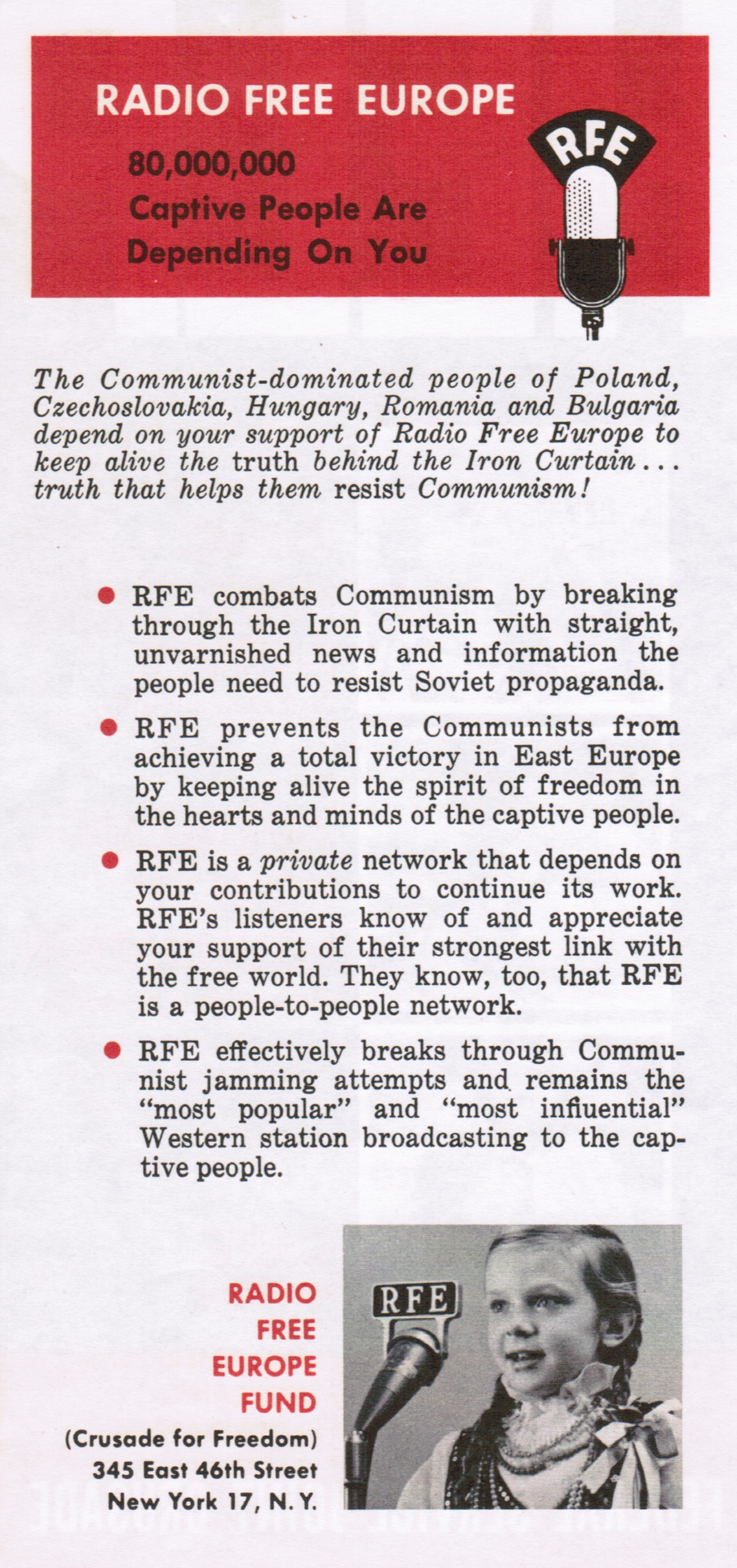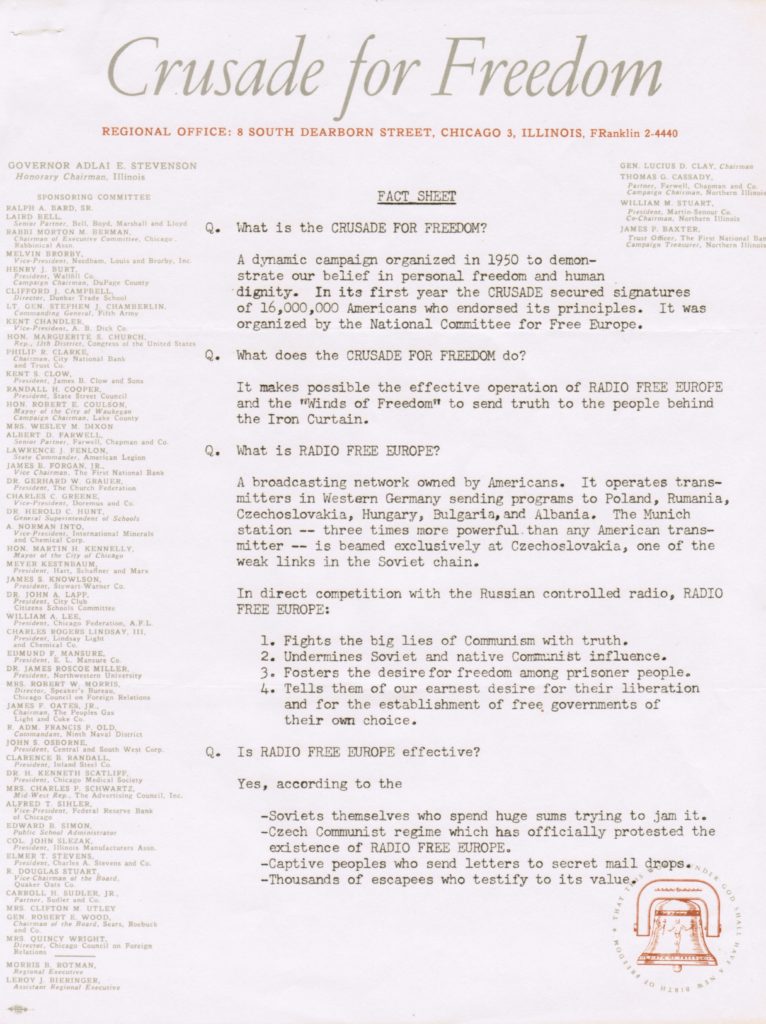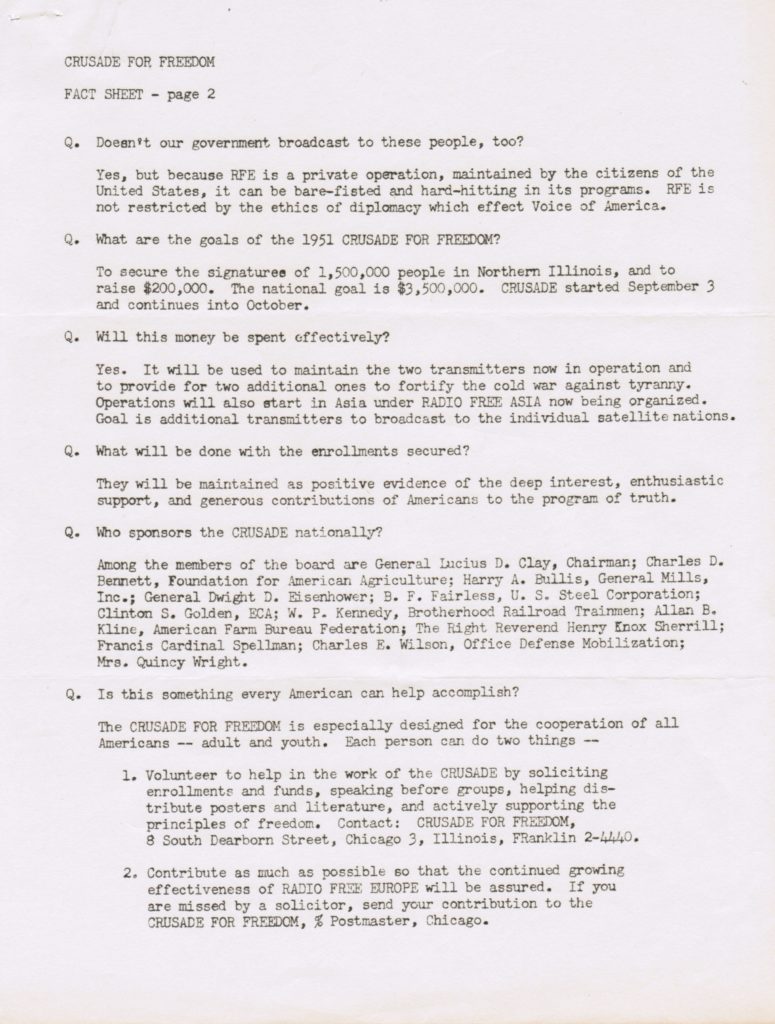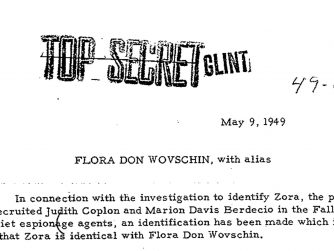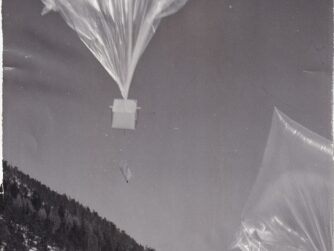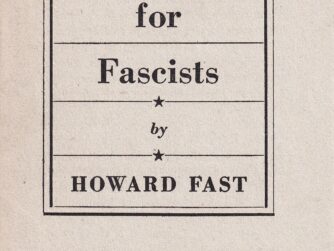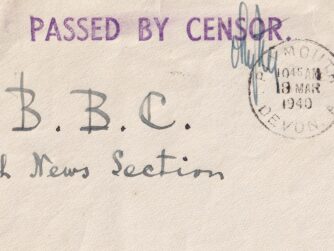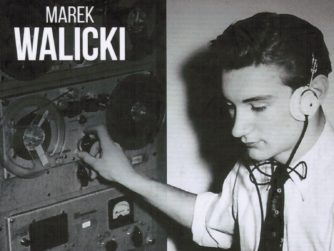This Cold War Radio Museum updated post covers Radio Free Europe advertising as well as a specific example of fundraising through the Federal Service Joint Crusade Campaigns in 1963.
RADIO FREE EUROPE
80,000,000
Captive People Are Depending On You
The Communist-dominated people of Poland, Czechoslovakia, Hungary, Romania and Bulgaria depend on your support of Radio Free Europe to keep alive the truth behind the Iron Curtain… truth that helps them resist Communism!
• RFE combats Communism by breaking through the Iron Curtain with straight, unvarnished news and information the people need to resist Soviet propaganda.
• RFE prevents the Communists from achieving a total victory in East Europe by keeping alive the spirit of freedom in the hearts and minds of the captive people.
• RFE is a private network that depends on your contributions to continue its work. RFE’s listeners know of and appreciate your support of their strongest link with the free world. They know, too, that RFE is a people-to-people network.
• RFE effectively breaks through Communist jamming attempts and remains the “most popular” and “most influential” Western station broadcasting to the captive people.
RADIO FREE EUROPE FUND
(Crusade for Freedom)
345 East 46th Street New York 17, N.Y.
DEPARTMENT OF HEALTH, EDUCATION, AND WELFARE
Office of Education
MEMORANDUM
TO: All Office of Education Employees
FROM : Francis Keppel, Commissioner of Education
SUBJECT: National Health Agencies and Federal Service Joint Crusade Campaigns
The National Health Agencies and Federal Service Joint Crusade Campaigns which are the second and final solicitation of the fiscal year, in accordance with the Federal fund-raising policy and program for personnel, will begin on March 11, 1963.
Six well-known voluntary agencies, i.e,: National Multiple Sclerosis Society, National Society for Crippled Children and Adults, United Cerebral Palsy Associations, American Cancer Society, American Heart Association, and Muscular Dystrophy Associations of America are supported by funds contributed to the National Health Agencies Program.
Three agencies, the American-Korean Foundation, Care, and Radio Free Europe receive funds contributed to the Federal Service Joint Crusade Campaign.
Your keyman will furnish you soon with the envelope for each of these campaigns and an informational brochure regarding the work of the individual organizations. Cash, not pledges, will be solicited, and our goal is 1007, voluntary participation.
This is your opportunity to make a donation to a specific agency for a purpose with which you are familiar and which you desire to support. Your gift will help in our fight against disease and hunger.
This ad for Radio Free Europe was placed in American magazines in 1969 toward the end of the CIA’s involvement with Radio Free Europe and Radio Liberty. Such advertising by Radio Free Europe in American media would also soon end.
This particular ad, as opposed to previous Crusade for Freedom and Radio Free Europe Fund ads, appears to be representing directly Radio Free Europe. It does not appeal to Americans for financial donations to support Radio Free Europe as the Crusade for Freedom and Radio Free Europe Fund ads did earlier. As it was confirmed later, these advertising and fundraising campaigns provided only a tiny fraction of money needed to run the station. Until 1971, almost all of Radio Free Europe’s budget came from funds secretly channeled by the Central Intelligence Agency (CIA) which also secretly managed the station.
The 1969 magazine ad shows two attractive but serious looking young people, a man and a woman, dressed in what could pass for Kalvin Kline clothes. They appear to listen intently to a small transistor radio which the woman is holding in her hand. Their faces express sadness and concern. The ad seems to suggest that Radio Free Europe is changing with the times as its audience is becoming younger. It seems designed to target young Americans in an attempt to convince them to become interested in Radio Free Europe and supportive of its mission.
Radio Free Europe
The In Sound from Outside
More than half the people in East Europe are under thirty. When they want to know what’s happening–they switch to Radio Free Europe. For the facts about East Europe and RFE, write Radio Free Europe, Box 1969, Mt. Vernon, New York 10551
ADVERTISING COUNCIL
advertising contributed for the public good
In his book, Radio Free Europe’s “Crusade for Freedom”: Rallying Americans Behind Cold War Broadcasting, 1950-1960, Richard H. Cummings, Director of Security for Radio Free Europe/Radio Liberty (RFE/RL) for 15 years beginning in 1980, describes in great detail Radio Free Europe’s “Crusade for Freedom” and its various public relations activities. It was the decades-long advertising and fund-raising campaign for Radio Free Europe, conducted mostly in the United States by the organization known as Crusade for Freedom Inc. In 1960, it was renamed as Radio Free Europe Fund and used it as its official name since December 1962.
The creation of Radio Free Europe was presented to the public as a private initiative launched in 1949 by a group of prominent Americans called the National Committee for a Free Europe. The creation of RFE was in fact a secret U.S. government initiative funded directly by the Central Intelligence Agency (CIA). The purpose of the Crusade for Freedom advertising campaign started by the National Committee for a Free Europe was to win the support of ordinary Americans for RFE’s mission of broadcasting uncensored news and commentary by shortwave and medium wave radio to the communist-ruled nations behind the Iron Curtain.
Robert T. Holt, an author of an early history of Radio Free Europe, does not mention the CIA connection in his book, radio free Europe, published in 1958, but he noted that U.S. government provided financial support.[ref]Robert T. Holt, radio free Europe (Minneapolis: University of Minnesota Press, 1958), p. 7.[/ref]
Some people might object to referring to RFE as a “private” or “unofficial” undertaking because it is commonly believed that it has received funds from the United States government. Obviously any financial relationship that might exist between Washington and RFE cannot be discussed in this volume. The important point is that the United States government emphasizes the private status of RFE.
Radio Free Europe broadcasts started on July 4, 1950 with a program beamed to Czechoslovakia. Radio broadcasts to other Soviet Block countries were soon added and quickly became highly popular among listeners in East Central Europe.
When in the early 1950s, the Crusade for Freedom organized an operation of sending millions of anti-communist leaflets in balloons across the Iron Curtain, the U.S. State Department responded to protests from communist regimes in Czechoslovakia and Hungary that both the radio and balloon-leaflet operations were undertaken by a private organization and that neither the U.S. government nor the U.S. authorities in West Germany were involved.[ref]Ibid.[/ref]
The U.S. diplomatic response was mostly untrue, but the times were different. In terms of the severity of government repression and media censorship, communist atrocities in the Soviet Block were not in any way comparable to today’s repressions and censorship in most countries, including Putin’s Russia. There were also no direct means of communications between individuals and groups, such as the Internet. Governments controlled most trans-national radio transmissions. They were too expensive and commercially unprofitable to be undertaken by the private sector. The need behind the Iron Curtain for government-funded surrogate (in place of local communist media) radio broadcasts, such as those by Radio Free Europe, was overwhelming and could not be met by anybody else, including the Voice of America. A 1951 Crusade for Freedom Fact Sheet said that “RFE is not restricted by the ethics of diplomacy which effect (sic) Voice of America.”
In the early years of the Cold War, some individuals in Eastern Europe caught listening or sending letters to RFE and VOA were sent to prison. Thousands of opponents of communist regimes were still being arrested and executed. RFE and later Radio Liberty, which broadcast to the Soviet Union, played a critical role in helping to undermine the communist monopoly on information. Over four decades, their radio broadcasts, as well as VOA broadcasts in the later years of the Cold War, contributed to the final collapse of the Soviet empire in the last decade of the 20th century.
By most accounts, the creation of Radio Free Europe and Radio Liberty was a noble effort funded by the U.S. government and supported by the vast majority of American people–probably the best investment ever made in defeating an oppressive, murderous and dangerous strategic enemy using peaceful, non-lethal means. U.S.-supported broadcasting behind the Iron Curtain was opposed only by the radical Left—American Communists such as Angela Davis—and a few Democrats in the U.S. Congress, most notably Senator J. William Fulbright (D-AR). Most other Democratic and Republican leaders and both Democratic and Republican administrations were highly supportive of the two radios. (In 2017, the Voice of America presented Angela Davis as a defender of workers’ and women’s rights.)
As some knew and many suspected, most of the funding for Radio Free Europe and Radio Liberty did not come from direct contributions to the Crusade for Freedom and Radio Free Europe Fund made over the years by individual American citizens and some West Europeans. The operating funds came secretly from the Central Intelligence Agency (CIA). The intelligence agency’s involvement with Radio Free Europe and Radio Liberty ended in 1972 after its managing role and funding were exposed in many media reports. Since that time, the radios have been paid for openly through appropriations from the U.S. Congress.
Even under CIA’s management, Radio Free Europe and Radio Liberty journalists enjoyed far greater independence than Voice of America (VOA) broadcasters. Started in 1942, VOA broadcast during the war promoted Soviet propaganda and repeated Soviet lies about the Katyn massacre of thousands of Polish militarny oficers while also suppressing other news that could shed light on Stalin’s crimes. Following World War II, VOA then under the State Department, engaged in limited censorship of news to which the Soviet government might object the most in diplomatic exchanges and its own propaganda, including the Katyn massacre, which was either ignored or minimized even in VOA’s Polish broadcasts in the later 1940s and as late as 1950-1951.
Most of such censorship by VOA’s management and some broadcasters stopped by 1952 as a result of criticism and pressure from members of both parties in the U.S. Congress. But during the Nixon-Ford administrations, VOA again engaged in limited censorship of some news related to Katyn.
In the 1970s, VOA’s senior management in response to directives from the United States Information Agency (USIA) and the White House banned reading long excerpts from books by Russian dissident writer Alexandr Solzhenitsyn.
Radio Free Europe and Radio Liberty, with headquarters in Munich, West Germany, never censored reporting on Katyn or readings from Solzhenitsyn’s The Gulag Archipelago. Their “unofficial” status protected them from most censorship pressure coming from the White House or the State Department, but the journalists working for the radios never actively opposed any long-term U.S. foreign policy objectives.
Before the CIA connection was revealed, many Americans were deceived by the Crusade for Freedom and Free Europe Fund advertising campaign into believing that the stations depended solely or mostly on private donations. American officials who proposed these campaigns were, however, convinced that their ultimately false claim of Radio Free Europe’s and Radio Liberty’s independence from U.S. government control and funding allowed the stations to be more hard-hitting on communism, reject criticism from communist regimes, and be more effective in countering Soviet propaganda. This strategy worked for a while, but in restrospect it was a mistake which was later corrected.
Radio Free Europe and Radio Liberty were in fact able to broadcast during the Cold War much more detailed local news and commentary about the countries in the Soviet Block than the openly U.S.-funded and U.S. government-controlled Voice of America. Whether it was necessary to keep the U.S. government’s funding support secret for many years to achieve this goal can be debatable, but the end result was positive, at least initially in the United States, and behind the Iron Curtain. Radio Free Europe was able to break the communist monopoly on local news, which was something that VOA was not able to do from New York and later from Washington under the control of the State Department and, in the later period of the Cold War, the United States Information Agency (USIA).
General Dwight D. Eisenhower, actor Ronald Reagan, television personality Ed Sullivan, CBS television news anchor Walter Cronkite, and entertainers Bob Hope and Bing Crosby were among many well-known Americans who appeared in various Crusade for Freedom commercials, radio programs and television films for American audiences.
Edward R. Murrow, a highly respected American journalist who during the Kennedy administration became the director of the United States Information Agency, narrated broadcasts in support of Radio Free Europe.
The Advertising Council, commonly known as the Ad Council, an American nonprofit organization that produces, distributes, and promotes public service announcements, helped to place various Radio Free Europe ads and commercials, including the “Freedom-Gram.” Americans were asked to sign “Freedom-Grams” to communicate their individual messages of support to persons behind the Iron Curtain.
Americans also signed earlier the campaign’s “Freedom Scroll” and donated money to Radio Free Europe. In return for their contributions, they were given Crusade for Freedom’s buttons with an image of the Freedom Bell.
A newspaper advertisement with a photograph of Dwight D. Eisenhower published in 1950 had this message from the former World War II Supreme Commander and future U.S. President
[ref]Richard H. Cummings, Radio Free Europe “Crusade for Freedom”: Rallying Americans Behind Cold War Broadcasting, 1950-1960 (Jefferson, NC: McFarland & Company, 2010), p. 31.[/ref]“THE Crusade for Freedom is a roll-call for all Americans who love freedom. Millions of signatures on the Freedom Scroll will give warning to aggressors and encouragement to the oppressed
“Your name on the Freedom Scroll will be enshrined with the Freedom Bell behind the Iron Curtain in Berlin, proclaiming your faith in God and your devotion to the cause of liberty everywhere.
“Your contribution to the Crusade for Freedom will help Radio Free Europe pierce the Iron Curtain…give hope and courage to 80 million people now living in Eastern Europe, who keep alive in their hearts the hope of freedom and self-government.
“I urge every American to join with the leader of the Crusade for Freedom, General Lucius D. Clay. By doing so, you will strengthen your country’s cause and comfort your country’s friends on both sides of the Iron Curtain.”
DWIGHT D. EISENHOWER
In 1951, Hollywood actor and future U.S. President Ronald Reagan recorded a television commercial for the Second Annual Crusade for Freedom Campaign.
[ref]Ibid., p. 53.[/ref]The commercial opened with:
My name is Ronald Reagan. Last year the contributions of 16 million Americans to the Crusade for Freedom made possible the World Freedom Bell–symbol of hope and freedom to the communist-dominated peoples of Eastern Europe. And built this powerful 135,000 Watt Radio Free Europe transmitter in Western Germany.
President Eisenhower repeated his support for the Crusade for Freedom and Radio Free Europe in a letter to Americans released in November 1954. He had a generally low opinion of the Voice of America and pointed out in his memoirs that early pro-Soviet and pro-communist VOA officials and broadcasters were insubordinate even toward already pro-Soviet President Roosevelt. In his book he condemned biased VOA officials and some reporters.
The CIA supported the Crusade for Freedom and later the Radio Free Europe Fund until 1968 and continued supporting Radio Free Europe until June 30, 1971. Its total support was slightly over $300 million.
Richard H. Cummings explained the initial secrecy surrounding the Crusade for Freedom and the Radio Free Europe Fund and their historical legacy.[ref]Ibid., p. 3.[/ref]
The dynamic early Cold War combination of Radio Free Europe and the Crusade for Freedom was a powerful change management tool of the U.S. government. This mobilization tool should not, in my opinion, be seen as an evil “deus ex machina” in the government’s Cold War activities but a successful evolutionary process involving the government, private industry, mass media, academia, religious leaders, and, lastly, “your average Joe.” The Crusade for Freedom could be termed a “fraud” on Americans, but it was, in my opinion a benign fraud: it probably gave most Americans what they wanted anyway: pageantry, a feeling of belonging and contributing to a justified cause–a Cold War consensus. I found no evidence that any individual or group financially profited from the contributions paid out in good faith for a good cause.
In Cummings’ view and in the view of listeners who benefitted from Radio Free Europe programs, including Ted Lipien, future director of the Voice of America Polish Service during Solidarity’s struggle for democracy in the 1980s and later VOA acting associate director, it was a benign and most likely also a necessary deception.
Sig Mickelson, former president of the Free Europe and the Radio Liberty Committees and later president of Radio Free Europe/Radio Liberty, Inc. reported in his book, America’s Other Voice: the Story of Radio Free Europe and Radio Liberty that “from 1951 through 1976, [Crusade for Freedom/Radio Free Europe Fund] receipts totaled about $50 million and campaign costs about $20 million, for a net of approximately $30 million, only a tiny fraction of the total sum required to operate Free Europe.”
[ref]Sig Mickelson, America’s Other Voice: The Story of Radio Free Europe and Radio Liberty (New York: Praeger, 1983), p. 58.[/ref]One of the goals of the Crusade for Freedom and the Free Europe Fund advertising and fund-raising campaign, as described in Mickelson’s book was “to acquaint citizens of the United States with efforts to preach the virtues of freedom to peoples behind the Iron Curtain.”[ref]Ibid.[/ref]
The most important goal, however, according to Mickelson was “to provide cover so it would appear the funding was derived from the general public and not from any governmental source, particularly not from the CIA.”[ref]Ibid.[/ref]
The United States maintained diplomatic relations with countries in the Soviet Block. When communist officials complained to American diplomats about Radio Free Europe broadcasts, they would respond that the U.S. government had no control over these broadcasts. They knew it was not true, but it helped to win the Cold War.
Millions of East Europeans and Soviet citizens were grateful for Radio Free Europe and Radio Liberty programs and did not care much how they were financed. Most assumed correctly that the U.S. government was firmly behind the broadcasting effort. It was not a well-kept secret.
Media reports in the West and some members of the United States Congress started to reveal in the 1960s the CIA’s involvement with the two radios. U.S. officials and members of Congress eventually concluded that open funding of Radio Free Europe and Radio Liberty and discontinuing the CIA’s role were a better option.


